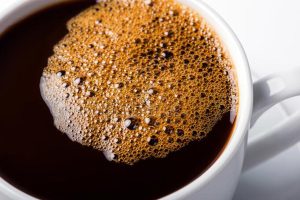If you are a regular coffee drinker, you know how you like your coffee.
Maybe strong and black like in Americanos, or thick and creamy as in dessert drinks like Mocha coffee. There are also those who like their coffee milky with a bit of caffeine like in Lattes.
You may know just how to expect your coffee, but have you ever asked yourself about the bubbles on top? They are probably one of the characteristics you ignore in coffee, like its aroma.
Unless there is something really off in a brew, like a burnt smell, most of us are unlikely to scrutinize our regular cup of joe too closely.
In this article, we will discuss the bubbles in your coffee and why they are there. That may make you look at your coffee a little differently the next time you go to the coffee shop.

What are The Bubbles in My Coffee Called?
When we talk about the bubbles in your coffee, we mean the froth you get on top of it. It’s made up of tiny bubbles that remind you of the gas in coke.
These coffee bubbles are called crema. They are made up of carbon dioxide that is released from coffee beans when they are used to brew coffee through a process called degassing.
The carbon dioxide released from coffee beans is trapped in them during the roasting process. The rate at which it is released is based on whether you use coffee beans or coffee grounds.
More carbon dioxide or bubbles are released after grinding coffee beans especially when they are heated in water.
How Does Carbon Dioxide Get Trapped in Coffee Beans During Roasting?
It’s pretty interesting to think of gas getting trapped in coffee beans during roasting and then being released during the brewing process. These are all heating processes, so why should one result in trapped gas while another leads to the release of the same gas?
Well, that’s just a scientific process referred to as Maillard Reaction. During that process, carbohydrates and amino acids in coffee beans react to heat in the roaster resulting in CO2 formation.
The longer you roast coffee beans, the more carbon dioxide gets trapped in them. That’s why you see more bubbles in coffee made using dark roast coffee beans than that brewed with light roasts.
That explains why CO2 is formed in coffee beans during roasting, but why does it get trapped in them?
Carbon dioxide is trapped in coffee beans during roasting as it tries to escape. Instead of finding its way out of the coffee beans, it forms a barrier that keeps oxygen out. That barrier is only broken when brewing coffee as the beans are once again exposed to extreme heat.
Degassing in Coffee Bags
You may not know it, but degassing also happens to coffee beans while they are in the coffee bag. That’s why these bags have a one – way valve that enables this process without exposing the coffee beans to oxygen from the atmosphere.
That is the only way to keep coffee beans fresh without exposing them to oxidation. A process whereby oxygen degrades coffee beans.
However, the degassing rate speeds up once you open the coffee bag, grind the coffee beans, and heat them up in hot water due to blooming.
Blooming refers to the way that coffee grounds swell and release bubbles during the extraction process. During this process, carbon dioxide is released from the grounds forming bubbles on top of the coffee, as water replaces it within the coffee grounds absorbing its flavor, oils, and aroma.
Once the brewing process is over, you end up with a flavorful, aromatic cup or carafe of coffee with a layer of bubbles on top. And it’s all because of degassing and blooming.
Should coffee Always Have Bubbles?
Whether you use a light or dark roast to brew your coffee, it should always have some amount of bubbles. It’s a sign that your coffee is fresh. A flat cup of coffee shows the coffee beans used to brew it are oxidized.
Coffee beans oxidize when you leave the bag open or store them in a container that lets in air. Once oxygen gets into your coffee beans, it forces any carbon dioxide out, meaning those beans will not produce crema during brewing. These beans are often referred to as old or stale.
Crema comprises the oils and flavors extracted from coffee beans by water. It contributes a lot to the makeup of a brew.
The more pressure you use during the coffee brewing process, the more crema you get in your brew.
Therefore, pour-over coffee-making only results in a slim layer of carbon dioxide gas, if any, as compared to what you get when making Espresso.
Is Crema Good For You?
We’ve learned a lot about coffee bubbles and how they are made but one question remains, are they good for you? Do they enhance the taste of a brew?
Unfortunately, while crema makes your coffee look inviting, it makes it bitter. It’s packed with concentrated coffee oils and flavors that give it an intense taste.
Some people prefer to stir it into their coffee while others skim it off. Others add creamer, hot water, milk, or sweetener to cut down the intensity resulting from thick crema especially in Espresso – based coffee.
If you enjoy a strong, flavorful cup of coffee, you should stir crema into your brew. That will give you a bold-tasting brew.
However, if you prefer a light-tasting brew, skim the bubbles or crema off your coffee. It will result in a sweeter brew with a lighter body.
Now that you know these facts, you can see that whether crema is good for you or not is up to you and your taste buds. But with this knowledge, the next time you see bubbles on your coffee, you’ll be able to tell where they’ve come from and how to incorporate them into your brew.